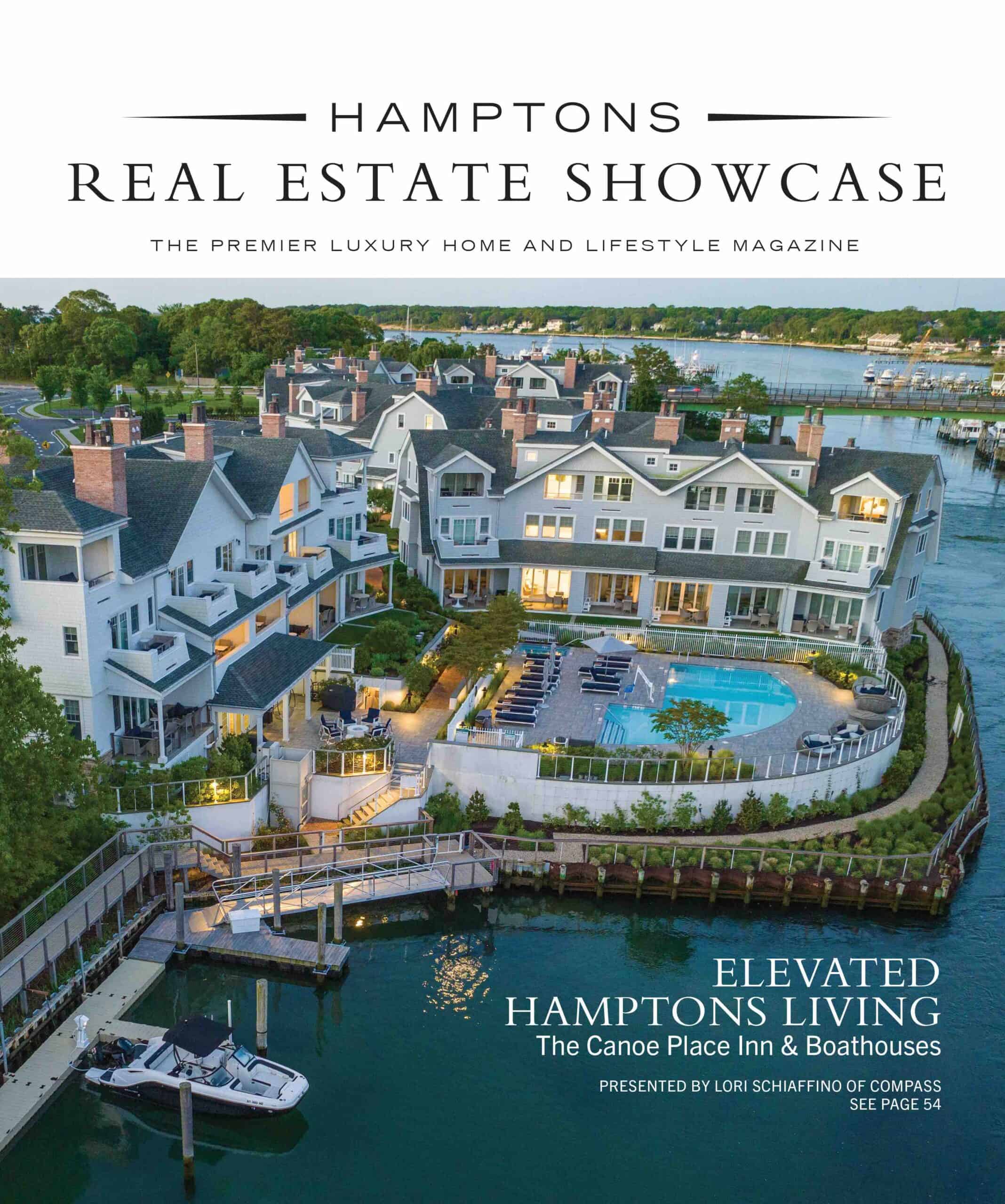Rare is the interior designer who will cheerfully decorate a spec house — and for good reason. How to furnish a home for occupants who have yet to make themselves known? Such projects oblige the designer to imagine the property’s prospective owners and act on instinct. All the minute decisions that are normally made in consultation with the homeowners — tile and floor finishes, trim details, light fixtures, wall paint, a color palette, and furniture — become wild card questions in an elaborate guessing game.
Given the stakes, most designers play it safe with innocuous interiors, clothing the house in the sartorial equivalent of plain dress. But those designers are not Alicia Murphy. For her, spec houses are a chance to take risks. She’ll try out bold color combinations and finishes that might otherwise prove a hard sell to homeowners.
The developers she works with, by contrast, grant her creative license. “I love ‘design-to-sell’ projects,” says Murphy, who is based in Amagansett, “because they allow me to respond to the space in an interesting way. Clients can have a hard time visualizing things which I know would look amazing. They’ll say, hmmm…a dark lacquered ceiling? That’s a big commitment!”
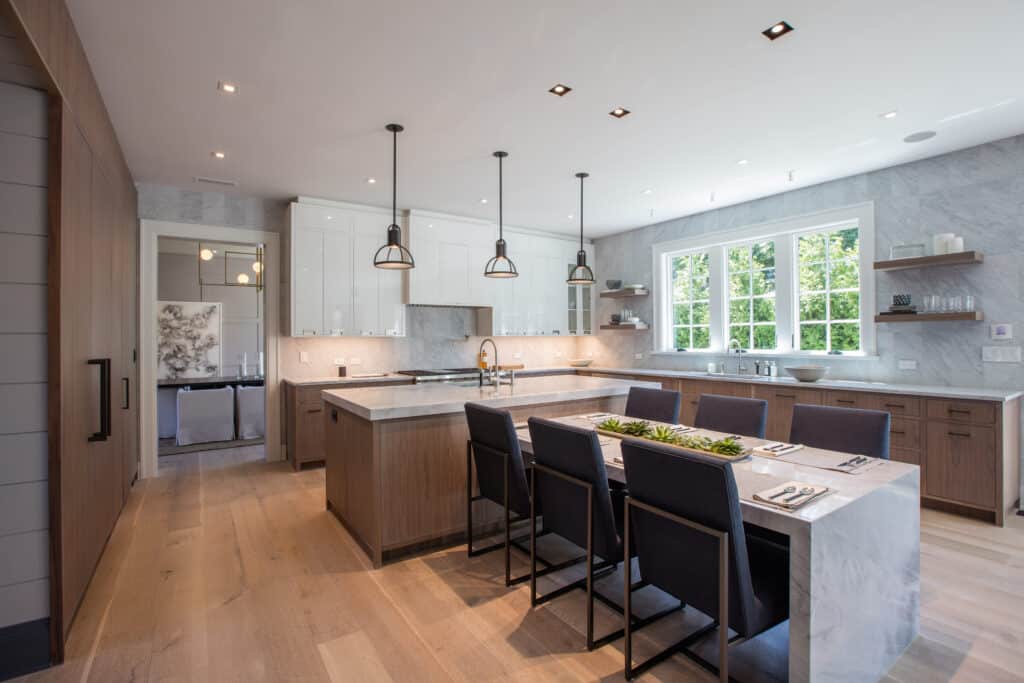
Murphy, who grew up in Huntington, Long Island, is known both for the youthful elegance of her work and her youthful clientele. In this context, one of her favorite projects in recent years was a 7,300-square-foot farmhouse-inspired home in Wainscott. Hired by a local developer to make the home move-in ready, Murphy painted the front door, the transoms over the interior doors, and the entrance hall window frames in black, “a cool design decision,” she says, “that adds dimension to hallways and rooms and served as a connecting color thread throughout.” Other touches that make a statement are the faux shagreen wallpaper on the dining room ceiling and the Murano glass chandelier — a custom piece by Venice M — over the live edge dining table.
The ‘design lab’ approach paid off in spades for Murphy. The house sold in just two weeks for $7.2 million, statement ceilings and all. “A lot of my clients live in brand new, high-end, ultra-modern buildings in the city,” she explains, “so I assumed the same would be true of most prospective buyers. I imagined a young family who liked the idea of a traditional Hamptons home, but not the lack of modern conveniences that come with it. My task was to reimagine those traditional spaces in a modern way with the level of comfort and detail my clients expect.”
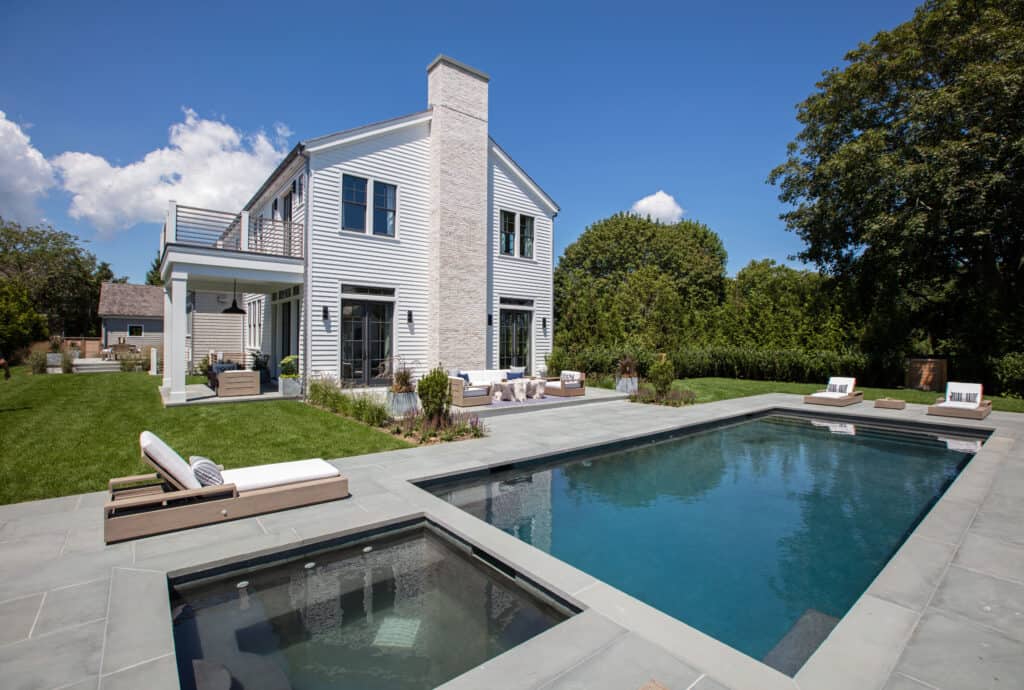
For example, the main bedroom has a fireplace — just the sort of cozy touch you’d expect to find in a farmhouse. But Murphy sought to infuse the space with a slightly more modern vibe, so she installed a limestone surround and a wood mantle which she painted in Farrow & Ball’s Charleston Grey with a high gloss finish for a lacquered look. She also paneled the fourteen foot-high ceiling in oak, both in deference to the farmhouse theme and to add warmth to the space. “Rooms with double-height ceilings can look cold and cavernous if you only have white sheet rock on the walls,” Murphy explains.
Without ever losing sight of the family she imagined would one day live in the house, she furnished the rooms with pieces from Restoration Hardware and vintage items from her own collection. Her instincts, as it turned out, were right on the money. The place went to a young couple from the U.K. who wanted a Hamptons retreat, but who weren’t inclined to undertake a transatlantic design project. Fortunately, they were able to move right in, because Alicia Murphy had already made their new house a home.




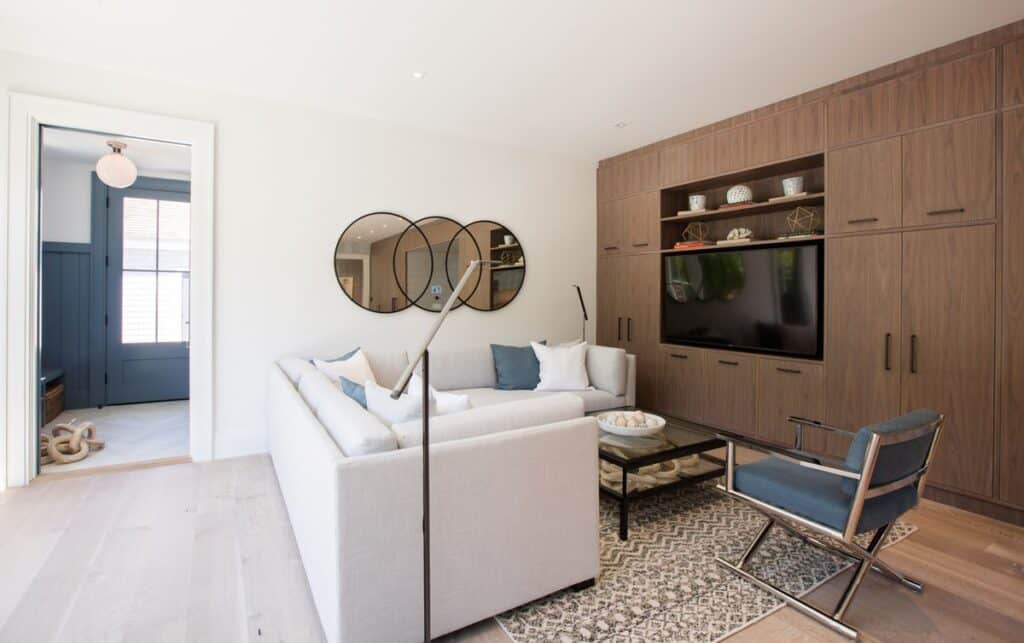
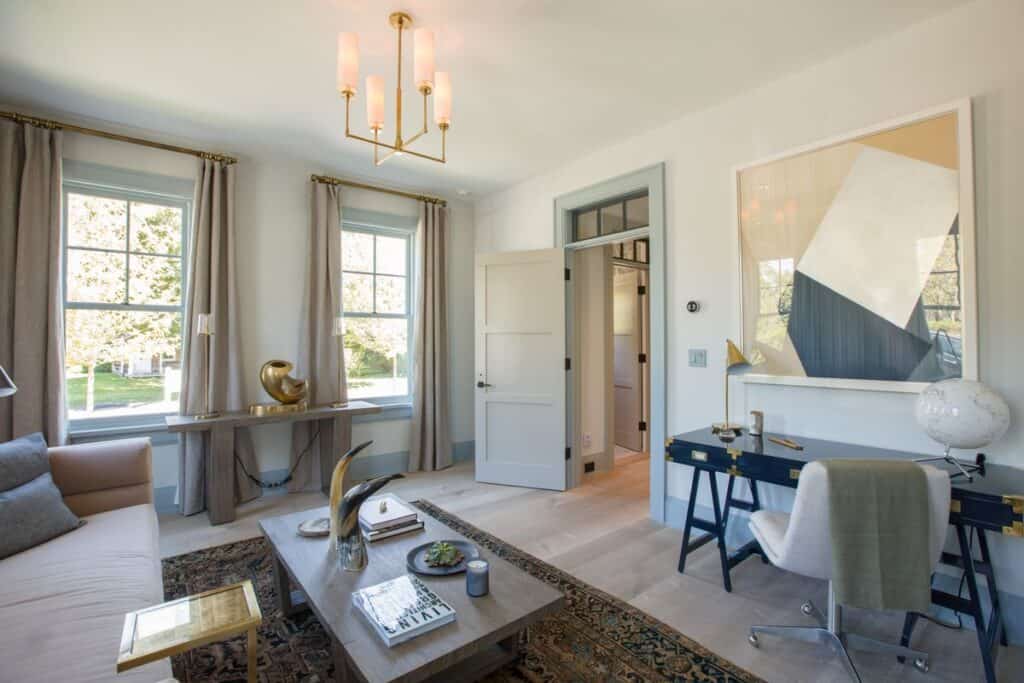
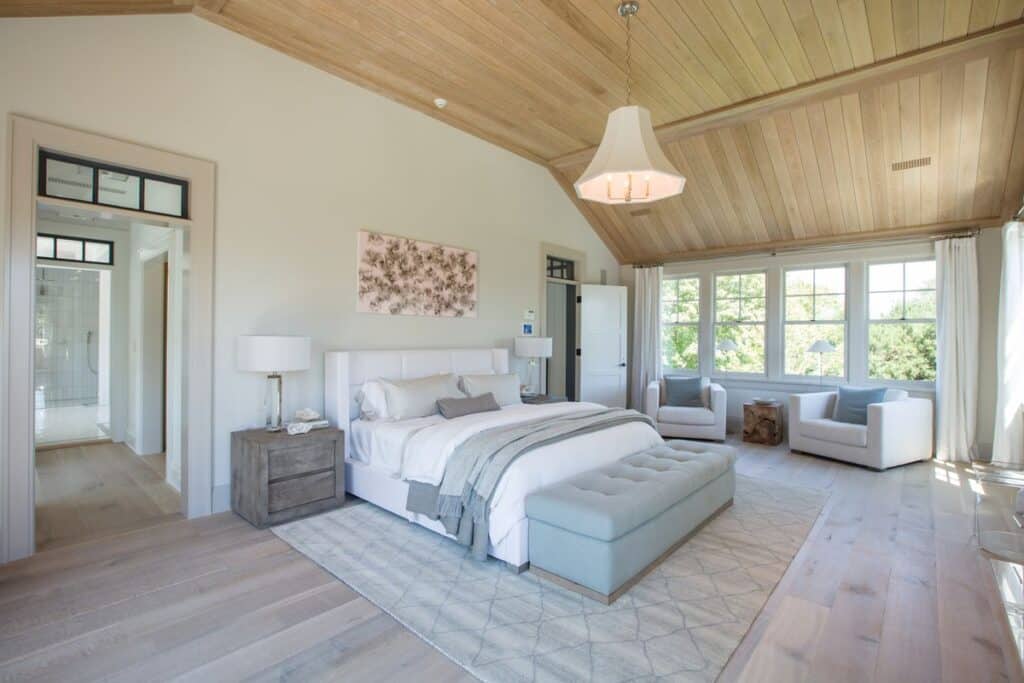
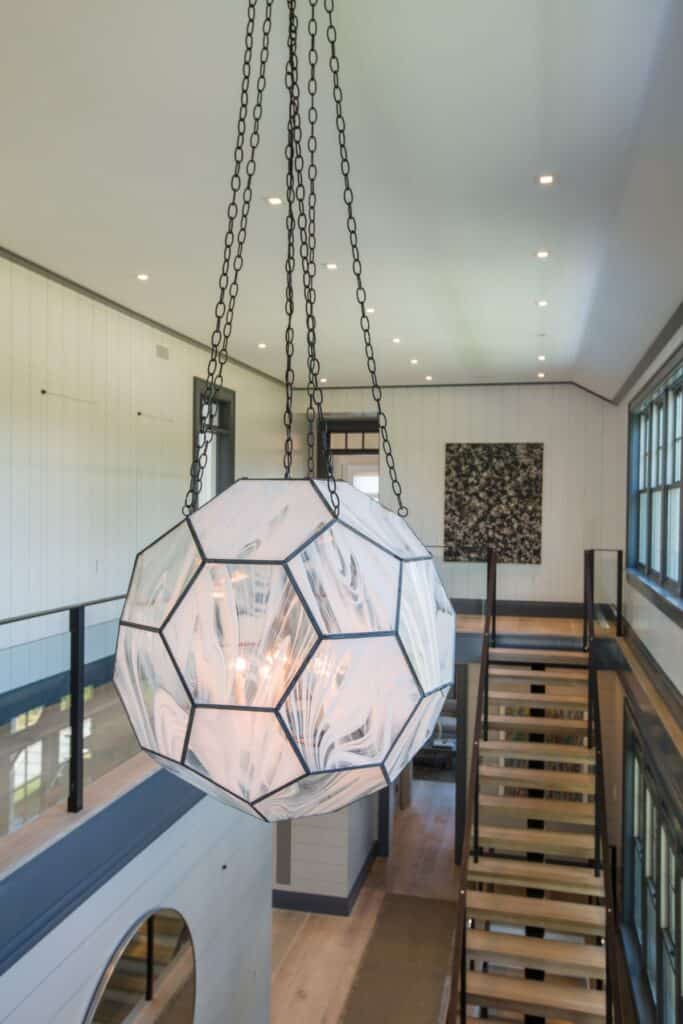





![First time ever on the market, this is a unique opportunity to own in the desirable and charming Historic District in the Village of Sag Harbor. 63 Glover Street is considered the most sought-after in the Village, boasting 100± ft. of panoramic water frontage, half bulkheaded, on Sag Harbor Cove with a deep water dock and a separate living cottage. Represented by @thebestofthehamptons of @brownharrisstevens. [link in bio]](https://hamptonsrealestateshowcase.com/wp-content/uploads/sb-instagram-feed-images/488065237_18501743197030135_1061235731645102537_nfull.webp)
![Drawing inspiration from the Greek Revival style of architecture, 7 Somers Place was developed by Sag Harbor master builder, Robert Tortora. The gracious living room with mantled masonry fireplace and elevated ceilings flows to the spacious dining room and custom light-filled kitchen. Represented by @thechrisritchey and Kim Hovey of @compass. [link in bio]](https://hamptonsrealestateshowcase.com/wp-content/uploads/sb-instagram-feed-images/488012730_18501545716030135_2576407923807360973_nfull.webp)
![Elegance and intelligence abound at this waterfront masterpiece with 8,065± sq ft, 7 bedrooms and 8.5 baths. 101 Jessup Lane boasts a sweeping double stairway entry hallway, 7 romantic fireplaces, a large gathering room, formal dining room, billiard room, and exercise room with sauna. Represented by @rydbergkent of @douglaselliman. [link in bio]](https://hamptonsrealestateshowcase.com/wp-content/uploads/sb-instagram-feed-images/486626595_18501344173030135_6414454892538890571_nfull.webp)
![Discover fabulous floral finds and nature-inspired treasures to bring beauty and charm to your life. Whether you’re adding a touch of nature to your home or finding the perfect gift, these blooming delights are sure to brighten your day! [link in bio]](https://hamptonsrealestateshowcase.com/wp-content/uploads/sb-instagram-feed-images/487711988_18500839267030135_4881948075500906108_nfull.webp)
![Spring, of course, leads inexorably into another summer season here in the Hamptons. According to agents we spoke to, demand is quite strong this year for rentals. A quality medium-priced property, well presented with amenities, is eagerly sought-after. Publicly listed rentals range from a high of $2.5 million, Memorial Day to Labor Day, on Cobb Lane in Water Mill, with quite a few more $1 million plus rentals than usual. [link in bio]](https://hamptonsrealestateshowcase.com/wp-content/uploads/sb-instagram-feed-images/486541532_18500603206030135_1827695170316201968_nfull.webp)
![Perched atop the dunes at Louse Point sits a picturesque house, perfect for enjoying all seasons that East Hampton has to offer. Situated on three quarters of an acre with almost 360 degree views of Gardiner’s Bay and Accabonac Harbor, 86 & 88 Louse Point are truly unique. Represented by @petrieteam of @compass. [link in bio]](https://hamptonsrealestateshowcase.com/wp-content/uploads/sb-instagram-feed-images/486615712_18500408650030135_1498783920053065135_nfull.webp)
![Set to be completed this year, this extraordinary property spans 2.5± acres of cleared land and showcases over 12,125± sq. ft. of architectural sophistication and refined design. With 9 bedrooms, 11 full baths, and 2 half baths, 261 Millstone Road offers an exceptional blend of spaces for both relaxation and entertainment. Represented by @susan.breitenbach of @thecorcorangroup. [link in bio]](https://hamptonsrealestateshowcase.com/wp-content/uploads/sb-instagram-feed-images/486599655_18500185618030135_8926656954621895711_nfull.webp)

